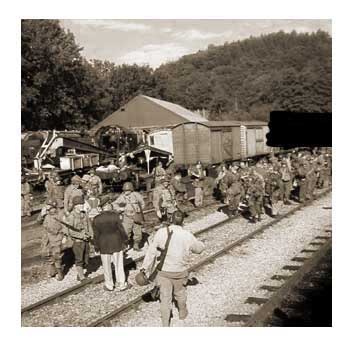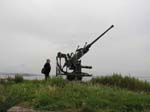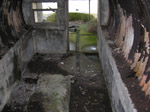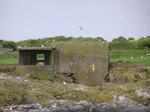
Rudloe
Manor, Jeeps and the Strategic Steam Reserve |
Long
viewed as a kind of British 'Area 51' , the vast underground complex at
Corsham, Rudloe Manor, Box near Bath, England was the wartime home of
a joint War Office/ U.S. Government plant for the assembly of the famous
'Jeep' light reconaissance truck. The plant turned out over 15,000 jeeps
between 1942-45 releasing thousands of tons of shipping space for other
uses. The complex was not however, excavated for military use being originally
a quarry for the famous Bath Stone. Parts were also used as an ammunition
store as well as a large district which was earmarked for government office
and residential use.
Jeep
manufacturing in the UK was carried out in the Rudloe Tunnels near Bath,
England. This secretive outfit was buried (literally) deep in the west
country at Corsham, home of the uk top secret strategic
steam reserve just outside Bath, England.
The
rebuild plant at Rudloe operated in a section of the huge underground
quarries at Corsham in Wiltshire and produced thousands of jeeps in the
war - saving priceless shipping space on the North Atlantic convoys. The
Jeeps produced at Corsham are today much prized by military vehicle enthusiasts
as they contain many features not found on the US built versions including
soft seats, cigar lighters, starters that work all the time and windscreens
that don't have a horizontal bar at exactly eye level.
 |
Practice
makes Perfect
An unidentified
American unit on manouvers near the Strategic Reserve in August
1948.
Note that the
censor has blacked out the locomotive in the background. All strategic
reserve locomotives had their numbers removed to prevent identification.
Although the
main part of the strategic steam reserve was stored in the Corsham
quarries there were sub depots at varies locations throughout the
UK which could hold up to a couple of dozen locomotives.
Conspiracy
theory buffs have suggested the original Woodhead tunnels on the
former trans-penine Sheffield-Manchester route as the possible location
of a northern strategic reserve.
|
After
hostilities ceased, the plant was 'mothballed' untill 1954 when increasing
cold war tensions required the creation of a 'strategic
steam reserve' for use in the aftermath of a nuclear attack. British
Railways Standard Class and ex Great Western Railway steam locomotives
were withdrawn from time to time and kept in storage ready for use after
'the balloon had gone up'.
 |
Where are they?
The locomotives
were generally taken over at the end of their alloted span on B.R
by crews from the Royal Engineers, who had been trained on the relevant
class on the Longmoor Military Railway.
Accompanied
by a British Rail inspector, the squaddies would generally take
over the loco at the start of a shift soon after 'booking on' and
the regular crew would be given the day off as an incentive not
to be too curious.
The engines
would be replaced by a spare for their rostered working and then
run light to a number of depots around the UK. They were then prepared
for storage and diesel hauled to the SSR. They would also be removed
from the B.R. records and listed as scrapped. |
Secure underground
storage
As well as
acres of secure storage space, the mothballed Jeep factory provided
both the tooling and the skilled pool of local labour - former employees
who were fitters, metalworkers, machinists etc. - necessary to keep
the stock of over over 160 locomotives in working order. As late
as 1982, long after the demise of steam on Britains railways, a
small staff of dedicated personnel were still carrying out care
and maintenance on the stock of slumbering giants. Astonishingly,
they were still using four or five slatgrill jeeps on a daily basis
almost forty years after production had ceased!
(Picture shows
unidentified SSR depot with assorted rolling stock and diesel loco) |
 |
Chargehand
Bob Watson who had been at Rudloe since 1943 explained why in a local
newspaper interview in 1992, almost ten years after the storage facility
was closed:
'When we stopped production at the end of the war, there were half a dozen
Jeeps in various areas of the factory that had failed QC [quality control]
for various reasons. When the last batch of production vehicles was despatched,
they were left and remained in the plant untill it was re-opened in the
mid fifties. A few of us decided they would be a bit better than the ministry
issue bike for getting around the site [over 100 acres on several levels]
so we rebuilt them from the stocks of parts that were left - I
kept mine running for years and, as they were never on inventory, when
I retired on March 28th 1988, I just got in one and drove it home...'
In 1983
however, as a result of another round of defence cuts, the
strategic steam reserve was deemed 'surplus to requirements' and the
locomotives were disposed of for scrap.
bunkers,
pill boxes and ex-military buildings
  
Please
note, we are not responsible for the content of external links or the
veracity or otherwise of any information or advert contained on the site.
Any transactions are strictly between the buyer/seller at their own risk.
We do not vet or check any advertiser and use of this site is at your
own risk.
|






